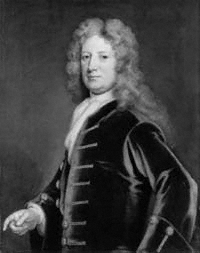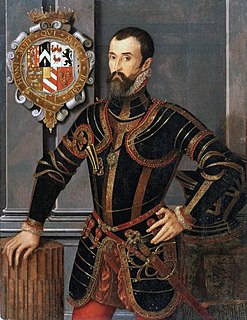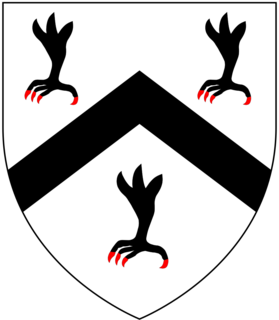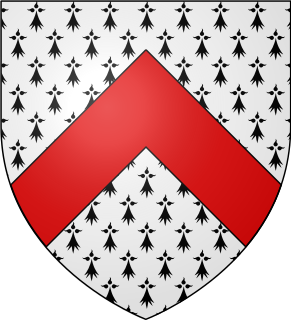
Mervyn Tuchet, 4th Earl of Castlehaven was the third son of Mervyn Tuchet, 2nd Earl of Castlehaven, and his first wife, Elizabeth Barnham. He succeeded his brother James Tuchet as Earl of Castlehaven on 11 October 1684. He also held the subsidiary titles 14th Baron Audley and 2nd Baron Audley of Hely.

Baron Wharton is a title in the Peerage of England, originally granted by letters patent to the heirs male of the 1st Baron, which was forfeited in 1729 when the last male-line heir was declared an outlaw. The Barony was erroneously revived in 1916 by writ of summons, thanks to an 1844 decision in the House of Lords based on absence of documentation. As such, the current Barony of Wharton could more accurately be listed as a new Barony, created in 1916, with the precedence of the older Barony.

Baron Braye, of Eaton Bray in the County of Bedford, is a title in the Peerage of England. It was created in 1529 for Edmund Braye, 1st Baron Braye. However the family originally originate from Normandy, they are direct descendants of Chevalier Baudry de Bray who came over to England in the battle of Hastings of 1066. The barony was created by writ, which means that it can descend through both male and female lines. He was succeeded by his son, the second Baron. He died from wounds received at the Battle of St Quentin in 1557. Lord Braye was childless and on his death the title fell into abeyance between his sisters.

Baron Grey de Wilton is a title that has been created twice, once in the Peerage of England (1295) and once in the Peerage of Great Britain (1784). The first creation was forfeit and the second creation is extinct.

George Talbot, 4th Earl of Shrewsbury, 4th Earl of Waterford, 10th Baron Talbot, KG, KB, PC was the son of John Talbot, 3rd Earl of Shrewsbury, and Lady Catherine Stafford, daughter of the 1st Duke of Buckingham. He also held the subsidiary titles of 13th Baron Strange of Blackmere and 9th Baron Furnivall.

William Herbert, 1st Earl of Pembroke, 1st Baron Herbert of CardiffKG was a Tudor period nobleman, politician, and courtier.

Thomas Vaux, 2nd Baron Vaux of Harrowden KB, English poet, was the eldest son of Nicholas Vaux, 1st Baron Vaux and his second wife, Anne Green, daughter of Sir Thomas Green, Lord of Nortons Green, and Joan Fogge. He was educated at Cambridge University. His mother was the maternal aunt of queen consort Catherine Parr, while his wife, Elizabeth Cheney, was a first cousin of the sixth and final wife of King Henry VIII.

William Knollys, 1st Earl of Banbury, KG, PC was an English nobleman at the court of Queen Elizabeth I and King James I.

Francis Talbot, 5th Earl of Shrewsbury, 5th Earl of Waterford, 11th Baron Talbot, KG was the son of George Talbot, 4th Earl of Shrewsbury, and Anne Hastings. He also held the subsidiary titles of 14th Baron Strange of Blackmere and 10th Baron Furnivall.
Thomas Wharton, 2nd Baron Wharton (1520–1572), of Wharton and Nateby, Westmoreland, Beaulieu alias New Hall, Essex and Westminster, Middlesex, was an English peer.

Henry Clifford, 2nd Earl of Cumberland was a member of the Clifford family, seated at Skipton Castle from 1310 to 1676. His wife was Lady Eleanor Brandon, a niece of King Henry VIII.

George Brooke, 9th Baron Cobham KG, lord of the Manor of Cobham, Kent and of Cooling Castle, Kent, was an English peer, soldier and magnate, who participated in the political turmoil following the death of King Henry VIII.
The Cave, later Cave-Browne, later Cave-Browne-Cave Baronetcy, of Stanford in the County of Northampton, is a title in the Baronetage of England.

Edmund Braye, 1st Baron Braye, of Eaton Bray in Bedfordshire, was an English peer.

Sir Thomas Leigh was an English merchant and Lord Mayor of London in 1558-59. He served as a City Alderman from 1552 until 1571.

Dorothy Bray, Baroness Chandos was an English noblewoman, who served as a Maid of Honour to three queens consort of King Henry VIII of England; Anne of Cleves, Catherine Howard, and Catherine Parr. From 1541 to 1543, she had an affair with the latter's brother, William Parr, 1st Marquess of Northampton, whose own wife, Anne Bourchier, 7th Baroness Bourchier had eloped with a lover.

John Tuchet, 8th Baron Audley, 5th Baron Tuchet was an English peer.
Baron Deincourt was a title which was created twice in the Peerage of England. The first creation is in abeyance and the second creation was forfeited.
Sarah Otway-Cave, 3rd Baroness Braye was an English noblewoman. The title of Baron Braye, originally created in 1529 for her ancestor Edmund Braye, 1st Baron Braye and abeyant since the death of the second baron in 1557, was called out of abeyance in her favor in 1839.

William Eure, 2nd Baron Eure was a Tudor-era English nobleman, soldier, and official in the Scottish Marches.

















